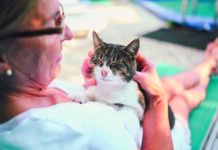For young adult and middle-aged cats, an annual wellness exam at the veterinarian’s is usually frequent enough. But during the senior and geriatric phases of a cat’s life, twice a year is called for, says the American Association of Feline Practitioners. The association labels age 11 as “senior” and age 15 as “geriatric.”
The reason for the recommended increase in examinations by a doctor is that in the life of an older cat, every 6 months is the equivalent of about 2 years in a person — enough time for significant health changes to occur. Among the things a vet should be checking at each semi-annual visit: weight and body condition; skin and coat quality; mouth, gums, and teeth; eyes and ears; heart and lungs; and joints and muscles.
The vet may also recommend ordering analysis of blood and urine samples and should ask questions about changes in your pet’s behavior. Is she eating and drinking more or less? Are there changes in litter box use? Have you noticed differences in your cat’s behavior or mood? Is your pet grooming as usual? All of these provide clues to her health status. You can be asking these questions yourself between visits to ascertain whether something might be amiss.



